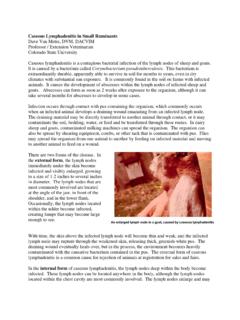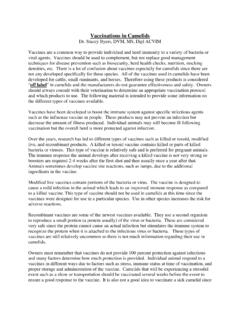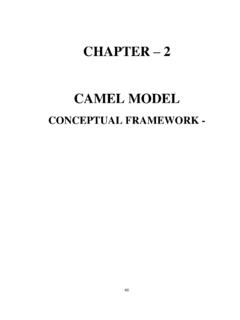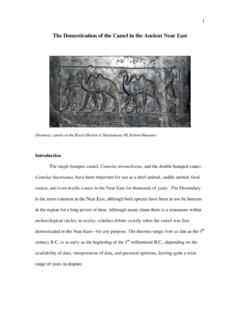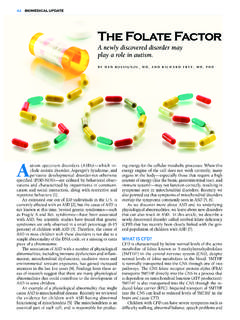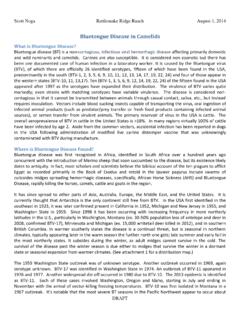Transcription of Parasite Management in Camelids - Colorado State University
1 Parasite Management in Camelids Stacey Byers, DVM, MS, Dipl ACVIM Internal or gastrointestinal (GI) Parasite Management rather than total eradication in Camelids may seem like an odd plan, but is becoming more important as we see developing Parasite resistance to medications. If we borrow some valuable lessons from other livestock species, tolerating low numbers of parasites in Camelids is a good thing for both the animals and owners. This Management method helps animals develop immunity, decreases Parasite drug resistance, saves money for owners, and finally because it is impossible to completely eliminate parasites.
2 1. How do parasites cause immunity? As animals are exposed to parasites, bacteria, viruses, etc., their immune system develops white blood cells that are used to fight infections to these foreign organisms. Some of these organisms cause the animal to have life-long protection after just one infection. In other cases, the animal may only be protected again diseases for only a few months. We know that low level, repeated exposure to a foreign organism can help the immune system continue making the protective cells to help prevent or reduce the impact of the disease. 2. Why is drug resistance important?
3 Parasite resistance to anthelmintics (anti- Parasite drugs) is increasingly common. We now know that we cannot completely eliminate an entire population of parasites from the GI tract of an animal. After giving an anthelmintic, many parasites are killed, however the few that remain are resistant to the drug, and with time reproduce and create a new population that is also resistant. Eggs from these parasites are then shed in the feces exposing herd-mates to the now resistant parasites. No new products are in development so veterinarians are concerned that we may run out of effective Parasite control drugs.
4 3. Are there ways to reduce the need for anthelmintics? Pasture and animal Management strategies can help decrease animal exposure to parasites and the need for anthelmintics. Use feed bunks rather than feeding on the ground Eliminating standing water and wet areas around waterers to remove the favorable environment most parasites need to become infective. Frequent cleanup of the dung pile and pasture rotation reduces the pasture contamination and chances of exposure. Unfortunately, young Camelids are notorious for not using the dung pile and these juveniles typically have the highest infection rates for GI parasites.
5 Their immune systems are immature compared to older animals. Until their immune systems have brought the initial infection under control, they can cause significant pasture contamination which can lead to infections in other juveniles or previously unexposed adults. Quarantine pens should be used for all Camelids entering your ranch. This includes new animals or those returning from breeding and shows. This policy reduces exposure of the existing herd to new Parasite species as well as other diseases. Incoming animals are stressed from transportation, new surroundings, and removal from existing herd mates.
6 The stress causes a mild immune suppression resulting in an increase in shedding of parasites or other organisms. Quarantining these animals for at least 4 weeks allows them to adjust to the new environment, feed and water, and allow their immune systems to bring infections under control. Random herd fecal sampling can be used to measure GI Parasite numbers. Concentrate on 3 general groups: crias in the first 2-6 months of life, yearlings, and adults. A sampling of 3-5 animals or 10% of the pen should be adequate. 4. What types of deworming programs are available? Deworming can be performed on a seasonal basis and/or as needed.
7 Which you use will vary by your geographical location, open or closed herd, pasture dry or irrigated, travel, stocking density, etc. Periodic fecal sampling (as described above) including fecal egg counts will provide information as to types and numbers of parasites present and if deworming is needed. You should review your particular situation with your veterinarian, and in combination with fecal egg counts, determine the best deworming program for your situation. Juveniles should be closely monitored for signs of diarrhea, decreased weight gain or weight loss, or poor fiber coat, as these can indicate Parasite problems requiring more immediate attention.
8 Fortunately, the dry Colorado environment is not very Parasite -friendly and the summer and winter weather helps kill off many GI Parasite eggs. Unless animals are on irrigated pasture or the weather is unseasonably wet, some ranches may find they do not need regular deworming programs. The following information is a brief overview of the more common GI parasites seen in alpacas and llamas and some general information on the treatments available. It is strongly recommended that a veterinarian evaluate if treatment is warranted by examination of the animal or herd and fecal samples.
9 Use of anthelmintics does not replace good Management and pasture sanitation programs. Additionally, use of anthelmintics or dewormers is not without risk and all products are considered off-label in Camelids . No products are currently approved or have manufacturer treatment guidelines for alpacas or llamas. This means the manufacturer does not guarantee safety or effectiveness for use in these species. I. PROTOZOA A. Coccidia (Eimeria alpacae, E. lamae, E. macusaniensis, E. punoensis) This Parasite typically causes diarrhea and weight loss or lack of gain in crias and na ve (previously unexposed) or immunosuppressed adults.
10 There is no cross protection between species so adults can be infected and develop clinical disease from a different species. Treatment is typically only recommended if oocyst (egg) counts are significantly high with the presence of diarrhea. However if E. macusaniensis is suspected, treatment is often started regardless of finding oocysts in the feces since the Parasite can cause significant intestinal damage. Infection occurs by oral exposure can occur in as little as 4 days if oocysts are exposed to cool, moist conditions. Pasture Management is key to reduce exposure. The oocysts die in warm, dry pasture in 20-30 days but can persist for years in cool, damp environments.


